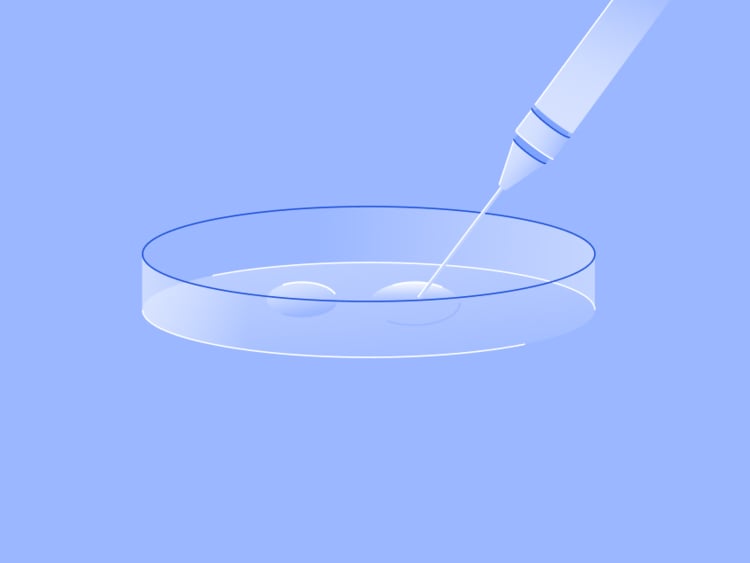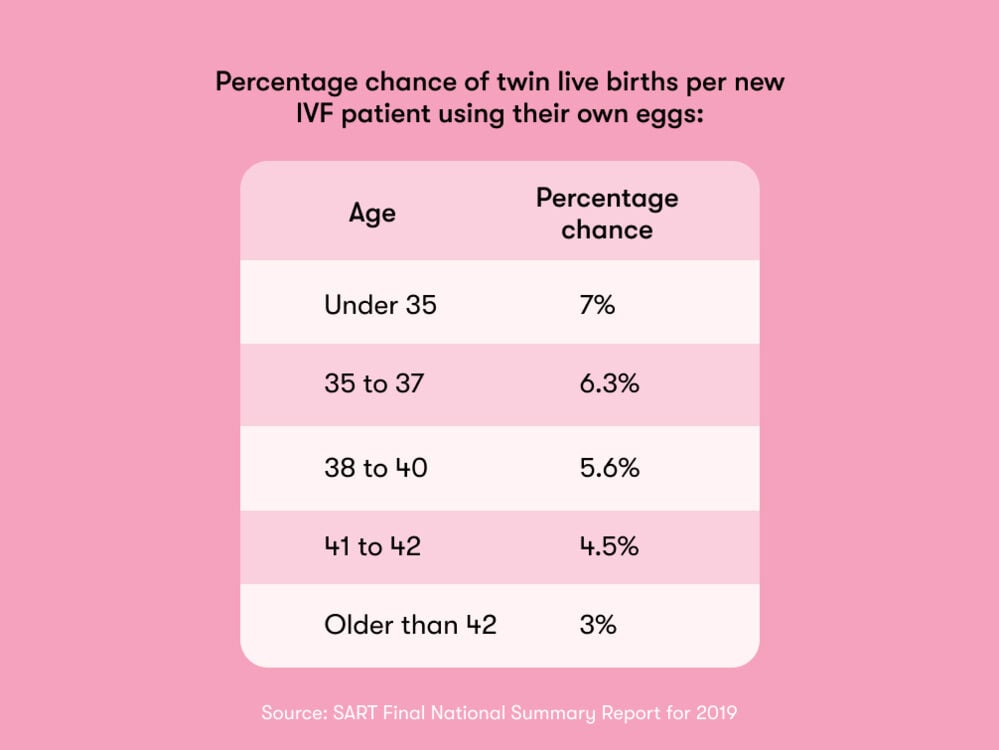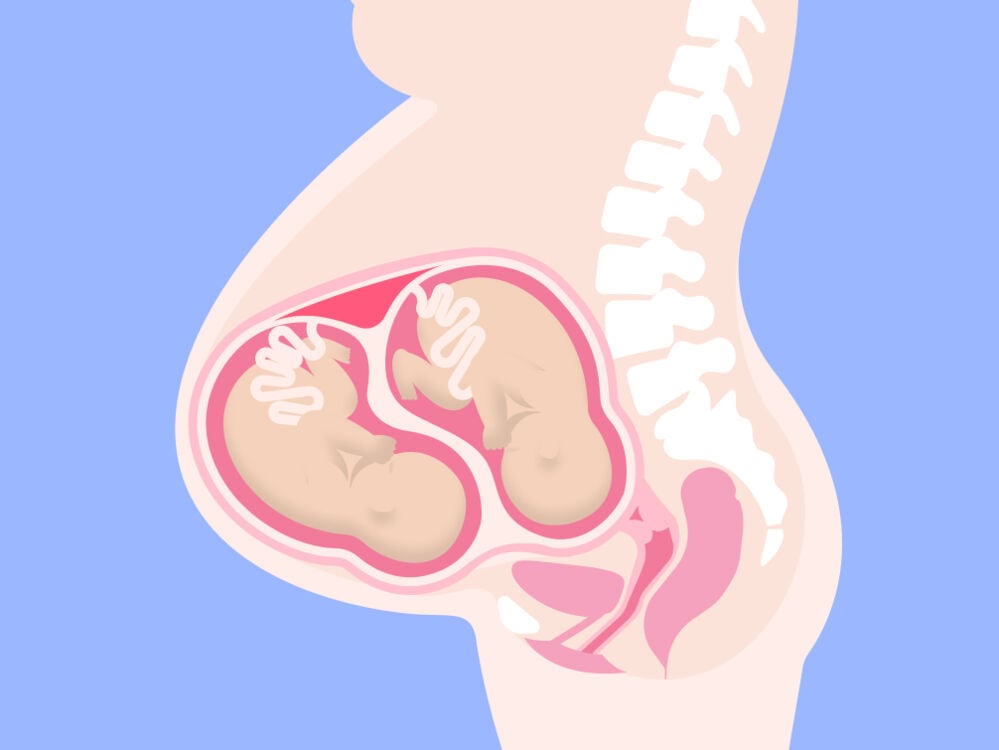IVF twins can feel like twice the miracle. But how likely is it to happen? And what’s it really like? Here, we ask a fertility expert and hear from a mom of IVF twins.
-
Tracking cycle
-
Getting pregnant
-
Pregnancy
-
Help Center
-
Flo for Partners
-
Anonymous Mode
-
Flo app reviews
-
Flo Premium New
-
Secret Chats New
-
Symptom Checker New
-
Your cycle
-
Health 360°
-
Getting pregnant
-
Pregnancy
-
Being a mom
-
LGBTQ+
-
Quizzes
-
Ovulation calculator
-
hCG calculator
-
Pregnancy test calculator
-
Menstrual cycle calculator
-
Period calculator
-
Implantation calculator
-
Pregnancy weeks to months calculator
-
Pregnancy due date calculator
-
IVF and FET due date calculator
-
Due date calculator by ultrasound
-
Medical Affairs
-
Science & Research
-
Pass It On Project New
-
Privacy Portal
-
Press Center
-
Flo Accuracy
-
Careers
-
Contact Us
IVF twins: How common are they really?


Every piece of content at Flo Health adheres to the highest editorial standards for language, style, and medical accuracy. To learn what we do to deliver the best health and lifestyle insights to you, check out our content review principles.
Do you know any twins? Chances are that you might, with twin births becoming more and more common over the last few decades. In fact, a recent study of births around the world found that the global twinning rate has increased by a third since the 1980s, with approximately 1.6 million twins being born every single year.
Researchers believe that one of the most important reasons for this increase is the coinciding rise in the use of fertility treatments, such as in vitro fertilization (IVF). But what are the chances of having IVF twins, and how does it happen?
Flo spoke to Dr. Lucky Sekhon, an OB-GYN (obstetrician and gynecologist), reproductive endocrinologist, and infertility specialist, to answer all of our questions. We also hear from Gillian Harvey, an author who’s had IVF twins (as well as a single IVF baby), to hear more on what an IVF twin pregnancy feels like.
How are twins conceived?
First, let’s refresh our minds on how twins are conceived. Nonidentical twins, or fraternal twins as they’re also known, are conceived when two separate eggs are fertilized by two different sperm. These are the most common type of twins. While exact percentages are unclear, research suggests that fraternal twins are also more common for older moms aged 35 and over, as hormonal changes can sometimes result in two eggs being released at the same time. This link may also be due to a higher rate of fertility treatment in older women.
Identical twins are more rare, resulting from a fertilized egg splitting and growing into two fetuses. The chances of having identical twins don’t differ according to age, but remain at around 1 in 250, or 0.4%.
Take a quiz
Find out what you can do with our Health Assistant
Are IVF twins more common than naturally conceived twins?
This is a tricky question to answer, because it depends on how you look at it. If you’re going by the number of twins in existence, there are thought to be more that are naturally conceived than those born as a result of IVF. That’s because IVF conceptions are less common than natural conceptions. Researchers estimate that fertility treatments account for less than 2% of all births in the US. One study analyzing multiple birth rates in the US estimated that only around one-third (36%) of all twin births are due to fertility treatments, with IVF accounting for approximately 17% of all twin births.
However, if you ignore the total number of twins and instead look at percentage chance, then the rate of twin births through IVF is actually higher than the rate of naturally conceived twins. That means you’ll get more twin births for every 100 IVF pregnancies than you will for every 100 natural pregnancies. This is because “IVF twins most often result from the transfer of multiple embryos into the uterus.” And it makes sense; if you have more than one embryo implanted into your uterus, an IVF multiple birth will be more likely, so you could become pregnant with twins, or even triplets, quadruplets, or more. Having said that, for patients who are predicted to have a good chance of success with IVF, fertility doctors prefer single embryo transfers because it maximizes the chances of giving birth to a healthy term baby.
What are the chances of having twins with IVF?
Many factors can impact your chances of having twins with IVF, including your age, whether the embryos are fresh or frozen, and whether you’re using your own eggs or donor eggs. Let’s take a look at some of the data to break this down into percentage likelihoods of having IVF twins.

The above chart shows the chance of having twins via IVF when using your own eggs, but with donor eggs, the likelihood is a little different. According to the same report, the average percentage of having IVF twins for women of all ages using fresh donor eggs was 11.5%, and this drops slightly to 8% for frozen donor eggs.
We don’t know the exact reasons behind these numbers, and as IVF is still a relatively new technique (the first procedure was performed in 1978), there is plenty more research and data to be uncovered surrounding it. However, the figures are still a helpful indication into the likelihood of having IVF twins according to different factors.
How do you get fraternal IVF twins and identical IVF twins?
Fraternal IVF twins occur when two embryos are successfully transferred and develop into two fetuses. Identical IVF twins occur when a successfully implanted embryo splits and develops into two fetuses.
“Fraternal IVF twins are more common than identical IVF twins,” says Dr. Sekhon. She explains that this is because “spontaneous splitting of a single embryo is a rare occurrence, happening 2% to 3% of the time from an IVF embryo.” Therefore, you have better chances of having twins with IVF from two embryos compared to the chances of having twins with IVF from one embryo. But as previously mentioned, a single embryo transfer leads to a better chance of having a healthy baby, so fertility specialists are instructed to follow this method when possible.

How can a pregnancy differ with twins? Is there more or less risk attached with having IVF twins compared to a single IVF pregnancy?
Unfortunately, a pregnancy with IVF twins differs from a pregnancy with a single IVF baby because it is deemed higher risk. “Twin pregnancies are 6 times more likely to be associated with preterm delivery [a birth that takes place before 37 weeks],” says Dr. Sekhon. “There are many risks associated with preterm delivery, including learning disabilities and cerebral palsy.”
While this may sound scary, it’s estimated that only 6 in 10 twins will be born before 37 weeks, so there is still a 40% chance that this won’t happen. And remember that the risks are exactly that: risks, not guarantees. However, if you’re concerned, speak to your doctor and see if there is any support available, such as more regular checkups.
Dr. Sekhon adds that other risks of an IVF twin pregnancy include “high blood pressure and diabetes in pregnancy, higher risk of miscarriage, and growth problems [for the infant].” Again, while this may sound concerning, remember that every pregnancy is different, and your health care provider should be available if you have any questions or would like more support.
How common are IVF triplets?
There is only limited information about triplet births and how frequently they result from IVF. However, one study estimates that approximately 77% of triplet and higher order births come from fertility treatments, including IVF. Interestingly, the same study also found a decline in the number of triplet births overall, which could be due to a corresponding decline in the number of embryos being transferred during IVF.
Having IVF twins: A real-life story
Now that we know the stats, what’s it actually like to have IVF twins? Author Gillian Harvey shares her story with Flo and compares the experience to her first pregnancy with a single IVF baby.
“When I discovered I was having twins, I was over the moon. I’d pretty much known that we wouldn’t be able to afford any more IVF rounds. This was our third, following an unsuccessful attempt in 2007 and a successful round in 2009. So having two felt great. But in retrospect, the twin pregnancy took a toll on my physical and mental health. It was hard.
“I soldiered on, and in the end my waters broke at 36 weeks and one day. Labor followed quickly. Contractions started at the hospital, and then everything went very quickly. I said I wanted to push, and when the midwife looked, she rushed me to a surgical room. [This is often a precaution in twin pregnancies as you might need an emergency C-section for the second twin.] They asked me to clamber onto a new gurney, but as I was on an epidural by then, I almost fell onto the floor! Joe was born about one minute later, then Tim was born two minutes after that. It was quite the experience!
"I was over the moon. I’d known that we wouldn’t be able to afford any more IVF rounds"
“The twins are total opposites, even now. When they were newborns, they were no different. Joe was always more fractious, Tim more calm. They were never in sync, which meant each would wake two to three times per night at different times. My husband Ray and I were exhausted. In the end, we developed a relay bedtime model. One would stay up until midnight with the two boys sleeping in their chairs then put the boys to bed with a night feed. The other would go to bed at 9pm. Then whoever had the early bedtime would do the next feed. This meant we each got around six hours’ sleep a night — and our sanity (or what was left of it) was saved!
“Having twins certainly took its toll, and going on any twin forum would fill me with fear. I just wanted the babies and loved the idea of having twins and a ‘complete family.’ That’s not to say it’s impossible. I’d advise anyone pregnant with twins to listen to their body and stay off scary internet forums.”
IVF twins: The takeaway
So, what have we learned about how common IVF twins really are? We know you’re more likely to have twins resulting from IVF than from a natural conception, and it’s clear that the rise in twin births globally could be due to the rise in use of IVF.
Having said that, the goal of IVF is to create one healthy baby, and that’s what your fertility consultants will always be working toward. If, by chance, you’ve ended up expecting IVF twins, you’ll know by now that this carries more of a risk than single IVF pregnancies. However, there is still every chance that you will go on to have a healthy pregnancy and babies, as Gillian’s story shows.
If you’re currently pregnant with twins, your health care providers will be taking extra care of you, so enjoy those two bundles of joy when they arrive!


Hey, I'm Anique
I started using Flo app to track my period and ovulation because we wanted to have a baby.


The Flo app helped me learn about my body and spot ovulation signs during our conception journey.


I vividly
remember the day
that we switched
Flo into
Pregnancy Mode — it was
such a special
moment.
Real stories, real results
Learn how the Flo app became an amazing cheerleader for us on our conception journey.
References
Adashi, Eli Y., and Roee Gutman. “Delayed Childbearing as a Growing, Previously Unrecognized Contributor to the National Plural Birth Excess.” Obstetrics and Gynecology, vol. 132, no. 4, Oct. 2018, pp. 999–1006.
“2014 Assisted Reproductive Technology National Summary Report.” Centers for Disease Control and Prevention, Society for Assisted Reproductive Technology, Oct. 2016, www.cdc.gov/art/pdf/2014-report/art-2014-national-summary-report.pdf.
Aston, K. I., et al. “Monozygotic Twinning Associated with Assisted Reproductive Technologies: A Review.” Reproduction, vol. 136, no. 4, Oct. 2008, pp. 377–86.
Eskew, Ashley M., and Emily S. Jungheim. “A History of Developments to Improve In Vitro Fertilization.” Missouri Medicine, vol. 114, no. 3, May 2017, pp. 156–59.
Kulkarni, Aniket D., et al. “Fertility Treatments and Multiple Births in the United States.” The New England Journal of Medicine, vol. 369, no. 23, Dec. 2013, pp. 2218–25.
Monden, Christiaan, et al. “Twin Peaks: More Twinning in Humans than Ever Before.” Human Reproduction, vol. 36, no. 6, May 2021, pp. 1666–73.
“National Summary Report.” SART, www.sartcorsonline.com/rptCSR_PublicMultYear.aspx. Accessed 20 June 2022.
Practice Committee of the American Society for Reproductive Medicine, and Practice Committee of the Society for Assisted Reproductive Technology. “Guidance on the Limits to the Number of Embryos to Transfer: A Committee Opinion.” Fertility and Sterility, vol. 116, no. 3, Sep. 2021, pp. 651–54.
“Premature Birth.” Mayo Clinic, 14 Apr. 2021, www.mayoclinic.org/diseases-conditions/premature-birth/symptoms-causes/syc-20376730.
“Single Embryo Transfer.” Centers for Disease Control and Prevention, 31 Jan. 2019, www.cdc.gov/art/patientresources/transfer.html.
Templeton, A. “IVF Treatment and Single Embryo Transfer.” Facts, Views & Vision in ObGyn, vol. 6, no. 1, 2014, pp. 5–6.
“Twin Pregnancy: What Twins or Multiples Mean for Mom.” Mayo Clinic, 25 Jan. 2022, www.mayoclinic.org/healthy-lifestyle/pregnancy-week-by-week/in-depth/twin-pregnancy/art-20048161.
“Antenatal Care with Twins.” NHS, www.nhs.uk/pregnancy/your-pregnancy-care/antenatal-care-with-twins/. Accessed 27 May 2022.
“Pregnant with Twins.” NHS, www.nhs.uk/pregnancy/finding-out/pregnant-with-twins/. Accessed 27 May 2022.




